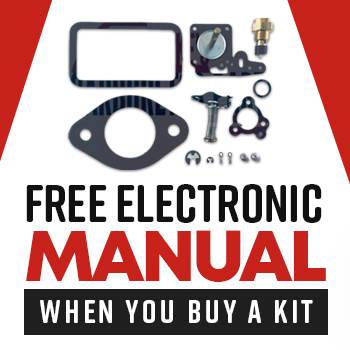If you are passionate about cars, you probably know about constant choke carburetors, constant vacuum carburetors, and multiple venturi carburetors. However, did you know that there is also another type of carburetor that is rarely mentioned? We are talking about electronic carburetors.
To be fair, electronic carburetors are not a different type of carburetor since they are based on one of the designs mentioned above. And this is what makes them intriguing. So what are electronic carburetors, and more importantly, how do they work? That is precisely the topic we will discuss today.
What is an electronic carburetor?
In simple terms, an electronic carburetor is an electro-mechanical device whose objective is to deliver the optimal amount of fuel to the engine. This mission is accomplished with the aid of several sensors that measure engine operating conditions, an electronic control unit (ECU), and a separate metering system controlled by the ECU used to adjust the final air-fuel ratio.
If this concept sounds familiar to electronic fuel injection systems (EFI), that’s because it is.
We must not forget that EFI systems became popular as a response to the strict emissions controls of the 1970s and 1980s, not because carburetors failed to perform their mission efficiently.
Then, as time went by, these fuel injection systems were perfected to the ones we know today, which provide excellent fuel economy and superior combustion efficiency.
So, from this perspective, you can think of electronic carburetors as the forerunners of today’s fuel injection systems.
How does the electronic carburetor work?
The operation of the electronic carburetor can be explained in three stages, data gathering, data processing, and mixture adjustment. Each stage will be explained in more detail next.
Data gathering
To regulate the air-fuel mixture, the ECU needs to monitor engine operating conditions continuously. To do this, it uses sensors similar to those in fuel injection vehicles. Among the parameters measured by these sensors are:
- Ambient air temperature
- Engine coolant temperature
- Throttle pedal switch (idle switch)
- Engine RPM (through the ignition module)
It’s worth noting that some electronic carburetors also use Lamba sensors (similar to O2 sensors), manifold air temperature sensors, and throttle position sensors.
Data processing
The ECU uses the data from the sensors to determine the ambient air density and approximate engine load. With this information, the ECU gets a better idea of the amount of air needed to adjust the stoichiometric ratio (air-fuel ratio) to achieve optimal combustion.
This calculation is not as accurate as in modern EFI systems, where a mass airflow sensor (MAF) measures exactly the engine’s air mass. Nevertheless, it’s accurate enough to make the necessary adjustments during different driving conditions such as cold start, idle speed, acceleration, cruise speed, and deceleration.
Air-fuel mixture adjustments
Depending on the electronic carburetor model, the ECU may have different mechanisms to adjust the air-fuel ratio. Generally, the ECU controls an alternate metering system using “actuators,” which may be a vacuum regulator, a stepper motor, or both. These actuators control the fuel flow through a tapered needle or a choke plate to vary the depression in the venturi.
Other control mechanisms may include a fuel cut-off valve, which, as the name implies, cuts off the fuel supply. This valve is activated when the throttle is closed, and the engine revs are high (sudden deceleration). On the other hand, idle control is usually done employing a stepper motor that operates the automatic choke to vary engine revolutions. Finally, an auxiliary cold starting system enriches the mixture when the engine is cold and progressively decreases it as the normal operating temperature is reached.
In summary, the ECU uses two principles to adjust the fuel mixture:
- It regulates the amount of air entering the carburetor using the automatic choke and the stepper motor (more air means leaner mixture).
- It regulates the amount of fuel entering the carburetor through a tapered needle controlled by a vacuum valve (or stepper motor)—the more fuel, the richer the mixture.
Electronic carburetors may seem archaic compared to the sophisticated systems found in modern gasoline direct injection (GDI) engines; however, their fuel delivery is significantly more efficient than conventional carburetors.
In fact, the only reason electronic carburetors did not catch on in the automotive industry was their high manufacturing cost. Even so, they paved the way for EFI systems and inspired the creation of hybrid systems that are still in use today.
Beyond electronic carburetors
You may think that electronic carburetors are a thing of the past. And in a way, you would be right. However, truth be told, there are still a large number of carbureted vehicles on the road. And most are still suffering from the common problems associated with this type of fuel system.
Some drivers have opted to install plug-and-play EFI systems such as Edelbrock’s Pro-Flo 4, whose ECU comes preloaded with more than 80 dyno-tuned calibrations for popular engines. However, that requires discarding the carburetor.
Fortunately, there are other solutions inspired by electronic carburetors. Classic car owners who don’t want such a radical solution as removing the carburetor can use a bolt-on system like the one developed by K&N, the Electronic Carburetor Injection (ECI).
While not formally an electronic carburetor, this innovative system adds a supplemental fuel source to your engine that aids cold starting and other conditions where the ECU deems it necessary.
Systems like K&N’s ECI allow you to keep your carburetor and thus preserve your engine as close to the original as possible. All in all, an improved version of the venerable electronic carburetor we have discussed.



